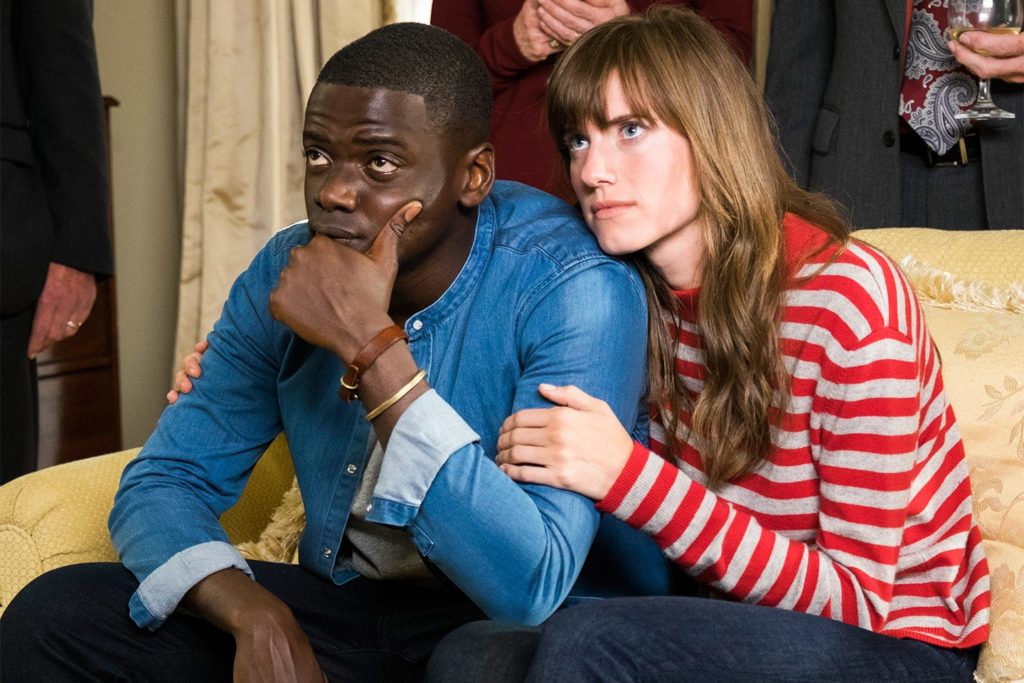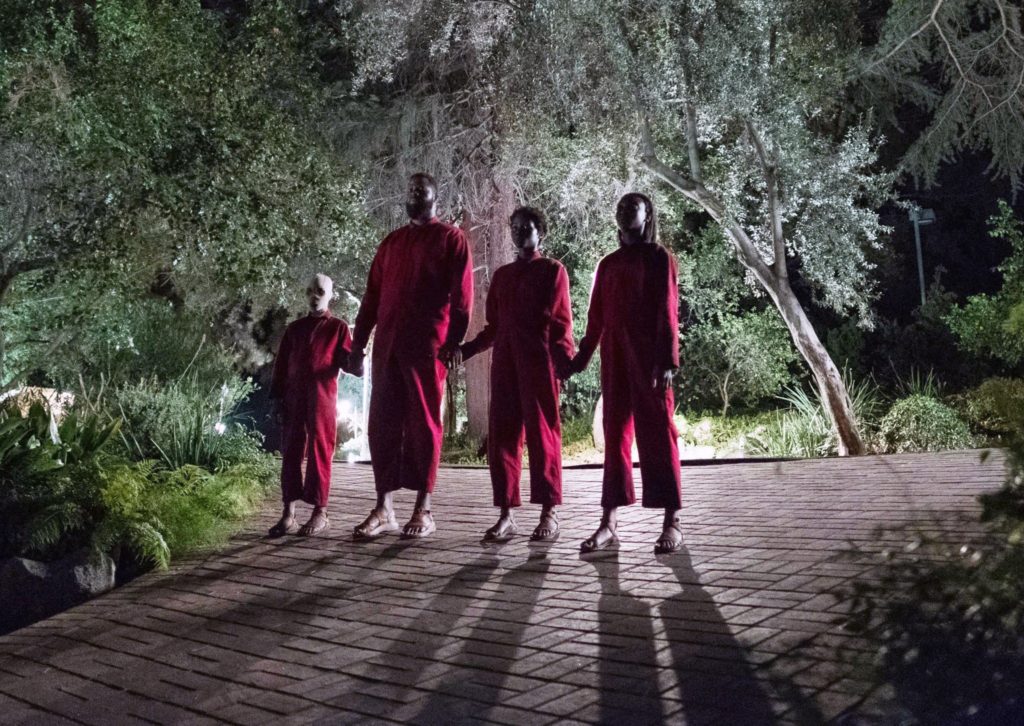A Look At Liberal Racism and Representation in Jordan Peele’s Get Out

In a society where the black films that win Oscars are usually about black trauma, there must be a space for black-made films about anything they want to be that can be recognised critically too.
Contribution by Shaznay Martin.
Filmmaking, like other forms of media consumption, has historically been utilised to communicate and reproduce dominant ideologies. Louis Althusser identifies the process of interpellation as the way in which ideas permeate into society’s individuals and influence the way they act whilst seeming like these ideas are our own. In ‘Black Spectatorship: Problems of Identification and Resistance’, Manthia Diawara highlights the ability of stereotypes and narrative subtexts to convey fictitious and detrimental meanings about the group represented; for example the idea that black men have an inherent sexual desire for white women. White people adopting these ideas of black people can often prove fatal, as symbolised by tragic incidents such as Emmett Till’s murder. Thus Diawara names the importance of active or resisting spectatorship so as not to internalise these problematic representations of black people as ‘natural, normal or inevitable’ (Dyer in Hall, 1997).

However, in more recent years black screenwriters and filmmakers have been able to create meaningful, imaginative, profound and varied depictions of the black experience, which in itself becomes a political act in its subversion and rejection of mainstream representation. In 1993, Diawara stated that “contemporary independent films continue the same effort of inquiring into Black subjectivities, the heterogeneity of Black lives, the Black family, class and gender relations, and diasporic aesthetics”. I arguethis is now starting to reflect in more mainstream black-written, directed and starred films.
One of these films is the critically acclaimed 2017 horror film Get Out, written and directed by Jordan Peele. The film follows black male protagonist Chris Washington who is in an interracial relationship with Rose Armitage.
To put it concisely, ‘liberal’, ‘colour-blind’ or ‘benevolent’ racism is “the set of ideologies and discourses that uphold contemporary racial inequality by denying either its presence or its significance” (Burke, 2017). The film is well recognised in its critique of liberal attitudes to race, which tends to overlook less overt forms of racism such as microaggressions, fetishism and cultural appropriation―all extremely pervasive issues that constitute a quotidian in black lives.

The Civil Rights Act of 1964, which outlawed racial, gender, and religion-based discrimination, prompted a shift to a ‘liberal’ mindset usually adopted by white democrats and some republicans. It brought white people to believe black people were automatically equal to them whilst acts of racism continued and took on new, less visible forms, creating amnesia of the past. This liberal mindset enabled racist behaviour to continue whilst simultaneously denying its existence: “the notion of a “colorblind” racism reflects the contemporary race project in its attempts to perpetuate existing structural inequality by obscuring the structural dimension of racial inequality” (Zamudio and Rios, 2006). However, many race theorists name power as a vital mechanism in racism (as well as prejudice), showing the impalpability of the notion that racism could be eradicated by a single law change.
To comfort Chris at the start of the film, Rose defends her parents’ virtue by saying her dad “would’ve voted for Obama for a third time if he could’ve”. Liberals consider changes in legislature and the existence of black people in a high position or status as a signifier that we live in a ‘post-racial’ society. Her comment embodies this concept―she denies the possibility of simultaneous truths―liking a famous black person and being racist. This also embodies the theory that racism is a continuum rather than a racist/non-racist binary, with most modern racism falling under the category of ‘silent’ racism. Additionally, Rose’s suggestion that Chris’ race is not important for her parents to know further illuminates her ‘colour-blind’ mentality. However, I argue her nonchalance about race initially makes the audience trust her. Peele also establishes this trust through her act of virtue signalling. For example, she complains when a police officer asks to see Chris’ license despite the fact he was not driving. Jordan and Rand (2019) describe virtue signalling as “feigned righteousness intended to make the speaker appear superior by condemning others”. A frequent shortcoming of virtue signalling is the absence of praxis; that often the person’s activism or allyship is performative and they do not act upon these views in everyday scenarios. This is particularly true of Rose.
Peele also utilises the horror genre to express his fears about white people. Use of the body-snatching trope along with comments like “black is in fashion” works as a metaphor for the commodification of black bodies and culture.

Bell Hooks argues that:
It is the young black male body that is seen as epitomizing this promise of wildness, of unlimited physical prowess and unbridled eroticism. It was this black body that was most “desired” for its labor in slavery, and it is this body that is most represented in contemporary popular culture as the body to be watched, imitated, desired, possessed” (1992).
This assumption is certainly embodied in the fascination and delight that the white guests seem to have upon meeting Chris. White people are increasingly engaging with black culture but largely through cultural appropriation. A recent example is Kim Kardashian calling cornrows “boxer braids”, effectively decontextualising the history of the hairstyle and claiming it as her own. It thus started a trend of white people using and misnaming the hairstyle, unacknowledging its origins. Blackness becomes “fashion”, something to buy and sell, as Peele demonstrates with the Armitage’s auctioning of Chris. Peele thus shows how white liberals, whilst ‘progressive’, can be complicit in racist behaviour such as fetishism and cultural appropriation.
However, not only does Peele critique liberal racism but in his portrayal of Chris, he deconstructs and challenges representations of black males on screen. In modern mainstream films black characters are often tokenised, stereotyped or ignored. For example, Green Book (2018) which won Best Picture at the Oscars, is a film that centres whiteness and white saviourism at the forefront of its racial commentary. It also presents blackness as being centred around stereotypes such as liking fried chicken and listening to Aretha Franklin, and thus suggesting Don Shirley was, in a sense, not ‘black’. In Hollywood’s history, on-screen African American representations have been mimetically flawed, as Donald Bogle famously maps out in Toms, Coons, Mulattoes, Mammies and Bucks (2006). And the legacy of these stereotypes is still prevalent in the media today. Followed by a history of blaxploitation and flawed representation, stereotypes on screen are harmful because they shape people’s views of that particular group.

This includes more recent ‘positive’ portrayals of black people as Hall argues it does not cancel out the negative images of black people, but rather creates a binary of positive / negative, giving white people a fixed, superficial, ‘either-or’ view of black people. Instead, Hall favours pluralist representation – i.e. diverse portrayals of black people. He argues “it greatly expands the range of racial representations and the complexity of what it means to ‘be black’, thus challenging the reductionism of earlier stereotypes” (1997).
Chris is not a stereotype and he is not de-racialised like many tokenised ‘positive’ images of black people in visual media or black actors cast colour blindly in white written roles. Instead, Peele signifies Chris’ blackness culturally, (aside from Daniel Kaluuya’s phenotypic blackness obviously,) in terms of his subscription to certain characteristics and symbols of blackness―ways of acting, speaking, moving, positioning (socially). Little acts like code-switching to AAVE (African American Vernacular English), fist-bumping (to Andre/Logan), relating to other black people: “they got you working hard out here” (said to Walter). He suggests that there is a culture of blackness that can be identified by a set of behaviours. De-racialised portrayals of black people are thus an issue Peele denounces through narrative, shown by the fear that is evoked when Chris is faced to potentially suffer the same fate as the Armitage staff.
However, I argue this happy ending fails to ground white audiences in the reality of being black. If an actual police officer showed up and saw a black man strangling a white woman it could have ended much differently. There would have likely been no justice for Chris, but Peele presents a more optimistic ending which could suggest to white spectators that the whole experience was nothing more than a bad dream and make them forget how very real racism is.

However, Peele did not write this film solely to educate white audiences. The hopeful ending serves as a peaceful break from the trauma black people experience in the real world, and from the frequent depiction of black trauma and suffering in black films. Chris being ‘saved’ by another black person is a powerful statement. No white saviour, no tragic ending. Thus we come back to the conception of plurality within black representations and content. Peele exercises his right to black filmmaker freedom with Us (2019):
“Scores of people will walk into this movie waiting for the racial commentary, and when it doesn’t come in the form they’re looking for, they’ll be forced to ask themselves: ‘Why did I think a movie with black people had to be about blackness?’” (Peele, 2019).
In a society where the black films that win Oscars are usually about black trauma (e.g. 12 Years a Slave(2013) won three), there must be a space for black-made films about anything they want to be that can be recognised critically too.
Horror movies help us to confront our fears, and by adding that resolved ending Peele gives black audiences a sense of power and hope over our mortality. He provides for us a space in which fears about being subjugated to the injustice of the system do not exist. He demonstrates that black people can make horror films that are not about the tragic reality of black life and tells black audiences that we won’t always die prematurely and we can have happy endings―and that in itself is so important. In Peele’s presentation of a black male lead who isn’t over-sexualised or masculinised, criminalised or de-racialised, Get Out critiques more than just liberal racism, it critiques the history of black filmic representation itself. By representing black people in the plural ways they exist, Peele’s films naturally reject racist stereotypes and images, rather than intentionally imploring white audiences to question themselves. He shows that black creations can be whatever they choose to be.
Contribution by Shaznay Martin.
Check out the GUAP Arts & Culture section, to discover new art, film, and creative individuals.

